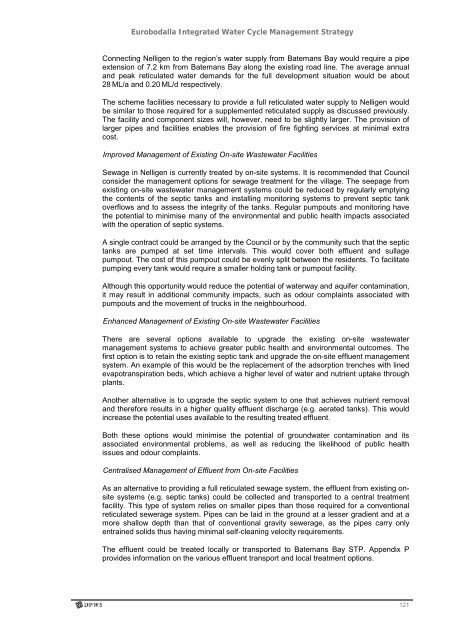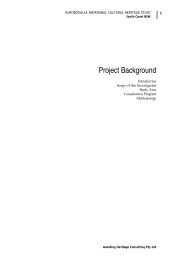Eurobodalla Integrated Water Cycle Management Strategy
Eurobodalla Integrated Water Cycle Management Strategy
Eurobodalla Integrated Water Cycle Management Strategy
Create successful ePaper yourself
Turn your PDF publications into a flip-book with our unique Google optimized e-Paper software.
<strong>Eurobodalla</strong> <strong>Integrated</strong> <strong>Water</strong> <strong>Cycle</strong> <strong>Management</strong> <strong>Strategy</strong><br />
Connecting Nelligen to the region’s water supply from Batemans Bay would require a pipe<br />
extension of 7.2 km from Batemans Bay along the existing road line. The average annual<br />
and peak reticulated water demands for the full development situation would be about<br />
28 ML/a and 0.20 ML/d respectively.<br />
The scheme facilities necessary to provide a full reticulated water supply to Nelligen would<br />
be similar to those required for a supplemented reticulated supply as discussed previously.<br />
The facility and component sizes will, however, need to be slightly larger. The provision of<br />
larger pipes and facilities enables the provision of fire fighting services at minimal extra<br />
cost.<br />
Improved <strong>Management</strong> of Existing On-site Wastewater Facilities<br />
Sewage in Nelligen is currently treated by on-site systems. It is recommended that Council<br />
consider the management options for sewage treatment for the village. The seepage from<br />
existing on-site wastewater management systems could be reduced by regularly emptying<br />
the contents of the septic tanks and installing monitoring systems to prevent septic tank<br />
overflows and to assess the integrity of the tanks. Regular pumpouts and monitoring have<br />
the potential to minimise many of the environmental and public health impacts associated<br />
with the operation of septic systems.<br />
A single contract could be arranged by the Council or by the community such that the septic<br />
tanks are pumped at set time intervals. This would cover both effluent and sullage<br />
pumpout. The cost of this pumpout could be evenly split between the residents. To facilitate<br />
pumping every tank would require a smaller holding tank or pumpout facility.<br />
Although this opportunity would reduce the potential of waterway and aquifer contamination,<br />
it may result in additional community impacts, such as odour complaints associated with<br />
pumpouts and the movement of trucks in the neighbourhood.<br />
Enhanced <strong>Management</strong> of Existing On-site Wastewater Facilities<br />
There are several options available to upgrade the existing on-site wastewater<br />
management systems to achieve greater public health and environmental outcomes. The<br />
first option is to retain the existing septic tank and upgrade the on-site effluent management<br />
system. An example of this would be the replacement of the adsorption trenches with lined<br />
evapotranspiration beds, which achieve a higher level of water and nutrient uptake through<br />
plants.<br />
Another alternative is to upgrade the septic system to one that achieves nutrient removal<br />
and therefore results in a higher quality effluent discharge (e.g. aerated tanks). This would<br />
increase the potential uses available to the resulting treated effluent.<br />
Both these options would minimise the potential of groundwater contamination and its<br />
associated environmental problems, as well as reducing the likelihood of public health<br />
issues and odour complaints.<br />
Centralised <strong>Management</strong> of Effluent from On-site Facilities<br />
As an alternative to providing a full reticulated sewage system, the effluent from existing onsite<br />
systems (e.g. septic tanks) could be collected and transported to a central treatment<br />
facility. This type of system relies on smaller pipes than those required for a conventional<br />
reticulated sewerage system. Pipes can be laid in the ground at a lesser gradient and at a<br />
more shallow depth than that of conventional gravity sewerage, as the pipes carry only<br />
entrained solids thus having minimal self-cleaning velocity requirements.<br />
The effluent could be treated locally or transported to Batemans Bay STP. Appendix P<br />
provides information on the various effluent transport and local treatment options.<br />
121

















